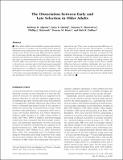| dc.contributor.author | Alperin, Brittany R. | |
| dc.contributor.author | Haring, Anna E. | |
| dc.contributor.author | Zhuravleva, Tatyana | |
| dc.contributor.author | Holcomb, Phillip J. | |
| dc.contributor.author | Rentz, Dorene May | |
| dc.contributor.author | Daffner, Kirk R. | |
| dc.date.accessioned | 2014-07-29T19:58:19Z | |
| dc.date.issued | 2013 | |
| dc.identifier | Quick submit: 2014-06-05T15:15:46-04:00 | |
| dc.identifier.citation | Alperin, Brittany R., Anna E. Haring, Tatyana Y. Zhuravleva, Phillip J. Holcomb, Dorene M. Rentz, and Kirk R. Daffner. 2013. “The Dissociation Between Early and Late Selection in Older Adults.” Journal of Cognitive Neuroscience 25, no. 12: 2189–2206. | en_US |
| dc.identifier.issn | 0898-929X | en_US |
| dc.identifier.uri | http://nrs.harvard.edu/urn-3:HUL.InstRepos:12605384 | |
| dc.description.abstract | Older adults exhibit a reduced ability to ignore task-irrelevant stimuli; however, it remains to be determined where along the information processing stream the most salient age-associated changes occur. In the current study, ERPs provided an opportunity to determine whether age-related differences in processing task-irrelevant stimuli were uniform across information processing stages or disproportionately affected either early or late selection. ERPs were measured in young and old adults during a color-selective attention task in which participants responded to target letters in a specified color (attend condition) while ignoring letters in a different color (ignore condition). Old participants were matched to two groups of young participants on the basis of neuropsychological test performance: one using age-appropriate norms and the other using test scores not adjusted for age. There were no age-associated differences in the magnitude of early selection (attend–ignore), as indexed by the size of the anterior selection positivity and posterior selection negativity. During late selection, as indexed by P3b amplitude, both groups of young participants generated neural responses to target letters under the attend versus ignore conditions that were highly differentiated. In striking contrast, old participants generated a P3b to target letters with no reliable differences between conditions. Individuals who were slow to initiate early selection appeared to be less successful at executing late selection. Despite relative preservation of the operations of early selection, processing delays may lead older participants to allocate excessive resources to task-irrelevant stimuli during late selection. | en_US |
| dc.language.iso | en_US | en_US |
| dc.publisher | MIT Press - Journals | en_US |
| dc.relation.isversionof | 10.1162/jocn_a_00456 | en_US |
| dash.license | LAA | |
| dc.title | The Dissociation between Early and Late Selection in Older Adults | en_US |
| dc.type | Journal Article | en_US |
| dc.date.updated | 2014-06-05T19:15:47Z | |
| dc.description.version | Version of Record | en_US |
| dc.rights.holder | Alperin, B. R. Haring, A. E. Zhuravleva, T. Y. Holcomb, P. J. Rentz, D. M. Daffner, K. R. | |
| dc.relation.journal | Journal of Cognitive Neuroscience | en_US |
| dash.depositing.author | Daffner, Kirk R. | |
| dc.date.available | 2014-07-29T19:58:19Z | |
| dc.identifier.doi | 10.1162/jocn_a_00456 | * |
| dash.contributor.affiliated | Levari, Tatyana | |
| dash.contributor.affiliated | Daffner, Kirk | |
| dash.contributor.affiliated | Rentz, Dorene | |


